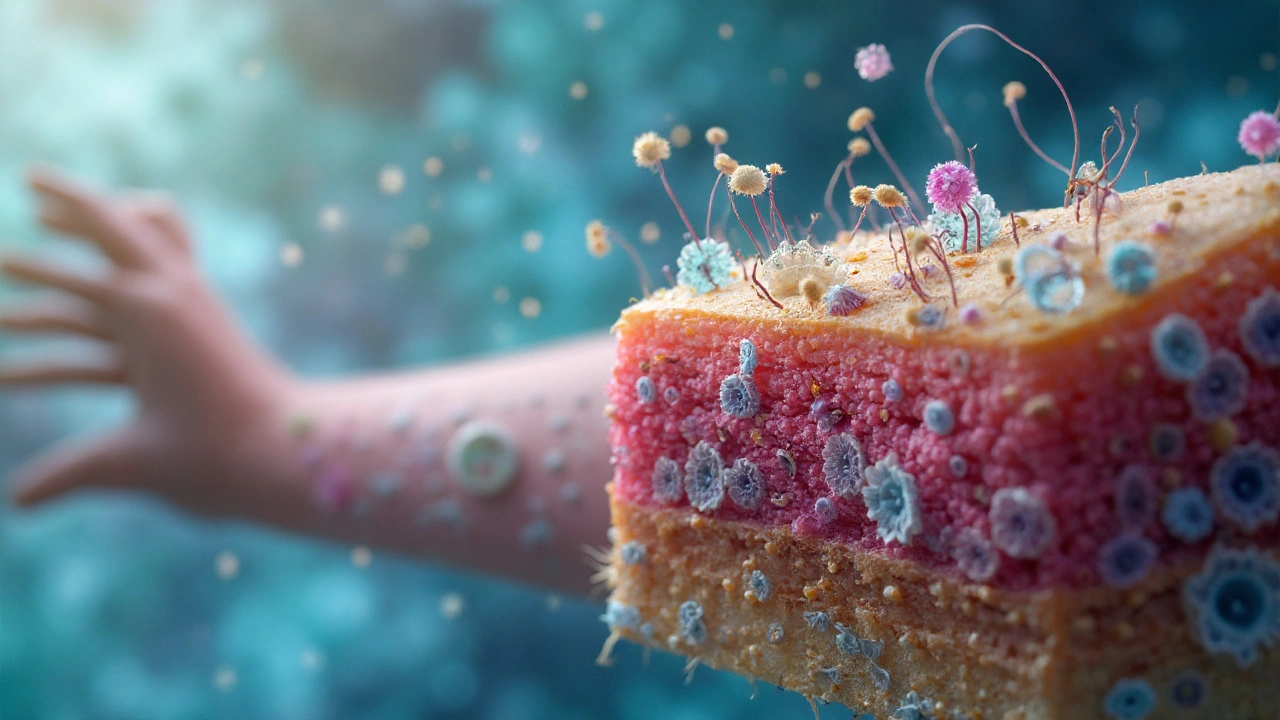Skin Microbiome is a diverse ecosystem of bacteria, fungi, viruses, and mites inhabiting the skin’s surface and deeper layers that regulates immunity, maintains barrier integrity, and deters harmful microbes. Understanding this hidden community is key to tackling common skin woes and achieving lasting skin health.
Key Takeaways
- The skin microbiome acts as a first‑line defense against pathogens.
- Dysbiosis can trigger acne, eczema, psoriasis and fungal infections.
- Topical and dietary probiotics, gentle cleansing, and balanced nutrition support a healthy microbiome.
- Modern sequencing tools reveal precise microbial fingerprints for personalized care.
What Exactly Is the Skin Microbiome?
Every square centimetre of our skin hosts up to onebillion microorganisms. The community is dominated by bacteria such as Staphylococcus epidermidis, a commensal Gram‑positive organism that produces antimicrobial peptides to keep foes at bay. Other major players include Cutibacterium acnes, historically blamed for acne but actually functioning as a lipid‑metabolising resident of oily zones. Fungal residents like Malassezia spp. thrive on sebaceous glands, helping to regulate skin‑surface lipids. Viruses and microscopic mites (Demodex) complete the picture, contributing to immune education.
How the Microbiome Shields Against Infections
Three core mechanisms keep the skin safe:
- Competitive exclusion: Beneficial microbes occupy niches and consume nutrients, leaving little room for invaders such as Staphylococcus aureus, a notorious pathogen linked to impetigo, cellulitis and atopic dermatitis flares.
- Antimicrobial production: Species like S. epidermidis secrete phenol‑soluble modulins and lipases that directly kill or inhibit pathogens.
- Immune modulation: Microbial‑derived short‑chain fatty acids (SCFAs) and lipoteichoic acids signal skin‑resident immune cells, prompting the release of defensins and encouraging regulatory T‑cell responses.
When these processes run smoothly, the skin remains resilient even after minor cuts or exposure to crowded environments.
Dysbiosis: When Balance Tips Over
Disruption - or dysbiosis - occurs when diversity drops or harmful species overgrow. The most common clinical footprints include:
- Acne vulgaris: An over‑abundance of lipase‑producing C. acnes strains combined with excess sebum fuels inflammation.
- Atopic dermatitis (eczema): Reduced S. epidermidis and elevated S. aureus colonisation exacerbate skin barrier breakdown.
- Psoriasis: Shifts toward Candida and Staphylococcus species aggravate Th‑17 mediated inflammation.
- Fungal infections (e.g., pityriasis versicolor): Over‑growth of Malassezia due to altered lipid composition.
Research from the British Dermatology Association (2023) reports that 68% of eczema patients show a >30% increase in S. aureus relative to healthy controls.

Factors That Tilt the Microbial Scale
Everyday choices shape the skin’s microscopic residents:
| Factor | Typical Effect | Practical Implication |
|---|---|---|
| Harsh soaps & high‑pH cleansers | Reduces overall diversity, favors opportunists | Switch to pH‑balanced, fragrance‑free cleansers |
| Broad‑spectrum antibiotics | Depletes commensals, allows resistant strains | Reserve antibiotics for confirmed infections; consider probiotic support |
| Excessive exfoliation | Disrupts barrier, alters micro‑habitats | Limit physical scrubs to 1‑2times/week |
| Diet high in refined sugars | Elevates sebum production, feeds C. acnes | Incorporate omega‑3 rich foods and low‑glycemic carbs |
| Environmental stress (pollution, UV) | Induces oxidative stress, shifts fungal populations | Use antioxidant‑rich moisturizers and sunscreen |
Supporting a Healthy Skin Microbiome
Practical steps backed by clinical data:
- Topical probiotics: Live‑culture creams containing Lactobacillus or Bifidobacterium strains have shown a 25% reduction in eczema severity scores after 8weeks (Dermatology Journal, 2022).
- Prebiotic ingredients: Niacinamide, inulin and alpha‑glucosyl‑hesperidin feed resident bacteria, enhancing barrier lipids.
- Gentle cleansing: Choose surfactants with a pH of 5.5‑6.0; avoid sodium lauryl sulfate.
- Targeted antimicrobial stewardship: Reserve benzoyl peroxide or clindamycin for active lesions; use narrow‑spectrum agents when possible.
- Diet and lifestyle: Incorporate fermented foods (kimchi, kefir) and polyphenol‑rich berries to boost systemic microbial diversity.
For readers who love data, a recent meta‑analysis of 12 probiotic trials reported an average 1.8‑point improvement on the SCORAD index for eczema patients using topical probiotic formulations.
Emerging Tools: From Sequencing to Microbiome Transplants
Advances in Metagenomic 16S rRNA sequencing allow clinicians to identify species‑level shifts without culturing. Companies now offer affordable at‑home skin swab kits, delivering a personalized report within days. Early‑phase studies are testing “skin microbiome transplants” where a curated mix of beneficial strains is applied to chronic eczema lesions, showing promising reduction in flare frequency.
While still experimental, these technologies illustrate a future where treatment is tailored to an individual’s microbial fingerprint rather than a one‑size‑fits‑all prescription.
Quick Checklist: Your Daily Microbiome‑Friendly Routine
- Cleanse with a pH‑balanced, fragrance‑free cleanser - 2minutes max.
- Apply a probiotic‑rich moisturizer after shower.
- Limit antibiotic courses; discuss probiotic adjuncts with your dermatologist.
- Eat at least one fermented food daily.
- Protect skin from UV and pollution using a broad‑spectrum sunscreen with antioxidant additives.
Adopting these habits helps keep the delicate equilibrium of your skin microbiome in check, reducing the odds of infection and inflammatory flare‑ups.

Frequently Asked Questions
Can I wash my face twice a day without harming my skin microbiome?
Yes, as long as you use a gentle, pH‑balanced cleanser and keep the contact time short. Over‑scrubbing or using harsh soaps can strip beneficial microbes and weaken the barrier.
Are oral probiotics effective for skin health?
Research shows that certain oral strains (e.g., Lactobacillus rhamnosus GG) can modulate systemic immunity and, in some cases, improve acne and eczema scores. Benefits are modest compared with topical applications, but they complement a holistic approach.
What’s the difference between S. epidermidis and S. aureus on the skin?
S. epidermidis is a harmless commensal that produces antimicrobial peptides and supports barrier function. S. aureus is a potential pathogen that can cause infections and worsen eczema when it dominates the microbial community.
Can I use antibiotics for acne without ruining my skin microbiome?
Short, targeted courses can be effective, but they often reduce beneficial bacteria and may lead to resistant strains. Pairing antibiotics with a probiotic regimen and limiting usage to flare‑ups helps mitigate damage.
Is there any risk in applying live‑culture probiotic creams?
For most people, probiotic creams are safe and well‑tolerated. Individuals with compromised immune systems should consult a physician, as rare cases of opportunistic infection have been reported with certain strains.







Abhay Chitnis
September 24, 2025Bro this is wild 🤯 I just washed my face with soap and water for 10 years and never got acne until I started using ‘pH-balanced’ cleansers. Turns out my skin was fine - it was the fancy products that messed it up. Who knew?